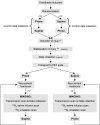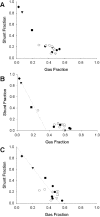Effect of prone position on regional shunt, aeration, and perfusion in experimental acute lung injury
- PMID: 15901611
- PMCID: PMC2718529
- DOI: 10.1164/rccm.200501-004OC
Effect of prone position on regional shunt, aeration, and perfusion in experimental acute lung injury
Abstract
Rationale: The prone position is used to improve gas exchange in patients with acute respiratory distress syndrome. However, the regional mechanism by which the prone position improves gas exchange in acutely injured lungs is still incompletely defined.
Methods: We used positron emission tomography imaging of [(13)N]nitrogen to assess the regional distribution of pulmonary shunt, aeration, perfusion, and ventilation in seven surfactant-depleted sheep in supine and prone positions.
Results: In the supine position, the dorsal lung regions had a high shunt fraction, high perfusion, and poor aeration. The prone position was associated with an increase in lung gas content and with a more uniform distribution of aeration, as the increase in aeration in dorsal lung regions was not offset by loss of aeration in ventral regions. Consequently, the shunt fraction decreased in dorsal regions in the prone position without a concomitant impairment of gas exchange in ventral regions, thus leading to a significant increase in the fraction of pulmonary perfusion participating in gas exchange. In addition, the vertical distribution of specific alveolar ventilation became more uniform in the prone position. A biphasic relation between regional shunt fraction and gas fraction showed low shunt for values of gas fraction higher than a threshold, and a steep linear increase in shunt for lower values of gas fraction.
Conclusion: In a surfactant-deficient model of lung injury, the prone position improved gas exchange by restoring aeration and decreasing shunt while preserving perfusion in dorsal lung regions, and by making the distribution of ventilation more uniform.
Figures







References
-
- Gattinoni L, Tognoni G, Pesenti A, Taccone P, Mascheroni D, Labarta V, Malacrida R, Di Giulio P, Fumagalli R, Pelosi P, et al. Effect of prone positioning on the survival of patients with acute respiratory failure. N Engl J Med 2001;345:568–573. - PubMed
-
- Papazian L, Bregeon F, Gaillat F, Thirion X, Gainnier M, Gregoire R, Saux P, Gouin F, Jammes Y, Auffray JP. Respective and combined effects of prone position and inhaled nitric oxide in patients with acute respiratory distress syndrome. Am J Respir Crit Care Med 1998;157:580–585. - PubMed
-
- Wiener CM, Kirk W, Albert RK. Prone position reverses gravitational distribution of perfusion in dog lungs with oleic acid-induced lung injury. J Appl Physiol 1990;68:1386–1392. - PubMed
-
- Lamm WJ, Graham MM, Albert RK. Mechanism by which the prone position improves oxygenation in acute lung injury. Am J Respir Crit Care Med 1994;150:184–193. - PubMed
-
- Gattinoni L, Vagginelli F, Carlesso E, Taccone P, Conte V, Chiumello D, Valenza F, Caironi P, Pesenti A. Decrease in PaCO2 with prone position is predictive of improved outcome in acute respiratory distress syndrome. Crit Care Med 2003;31:2727–2733. - PubMed
Publication types
MeSH terms
Substances
Grants and funding
LinkOut - more resources
Full Text Sources
Medical

